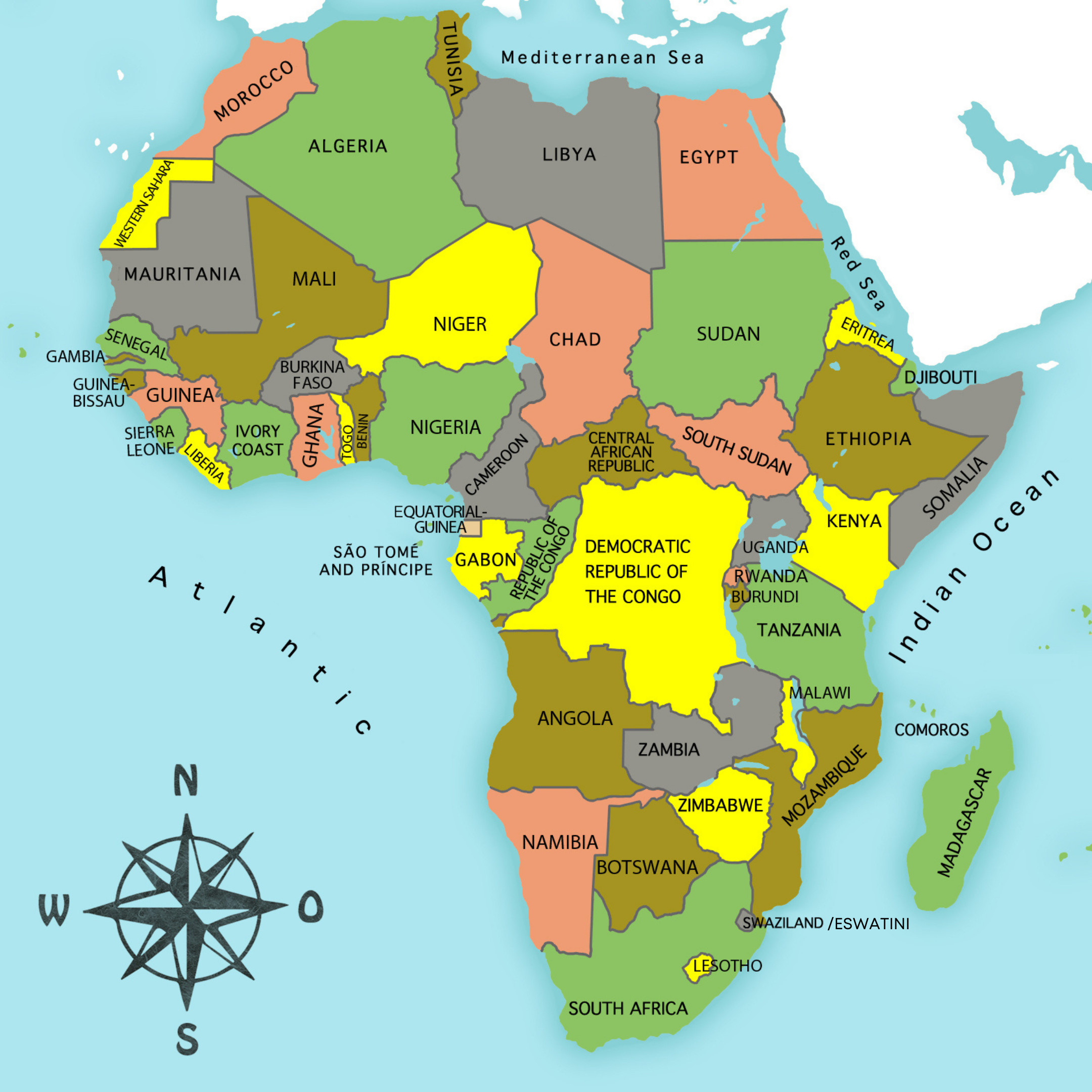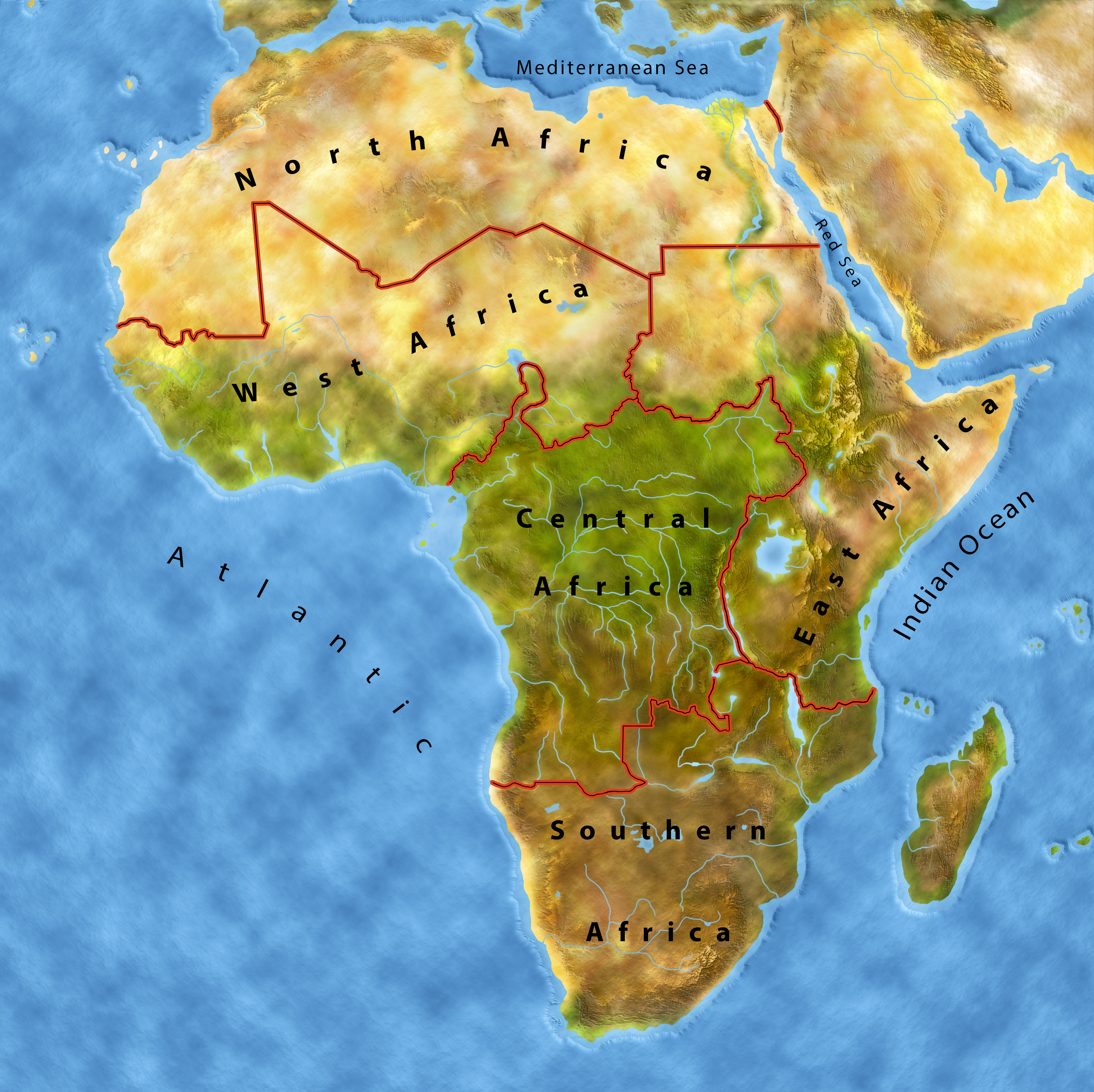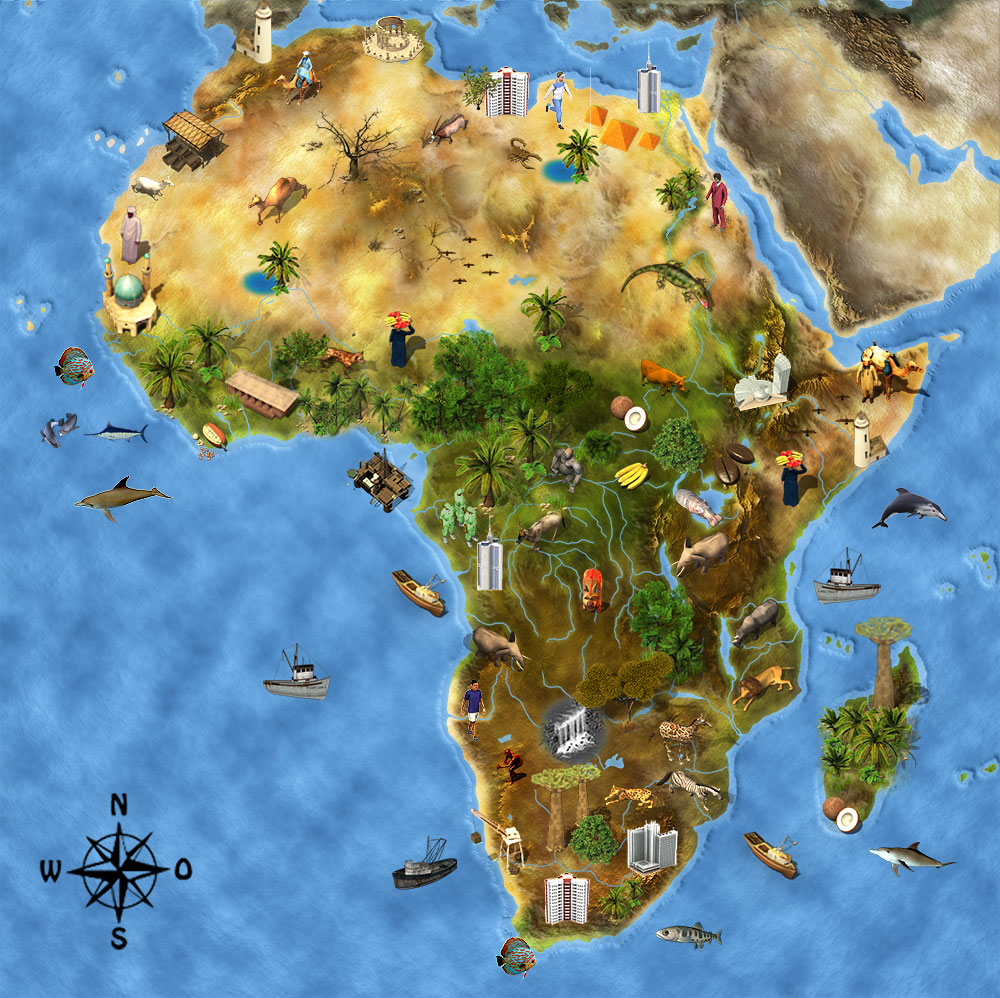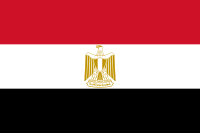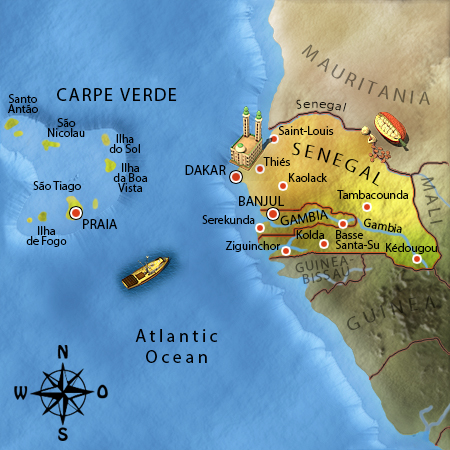Salama lay kum, welcome to Gambia, the smallest Country in West Africa!
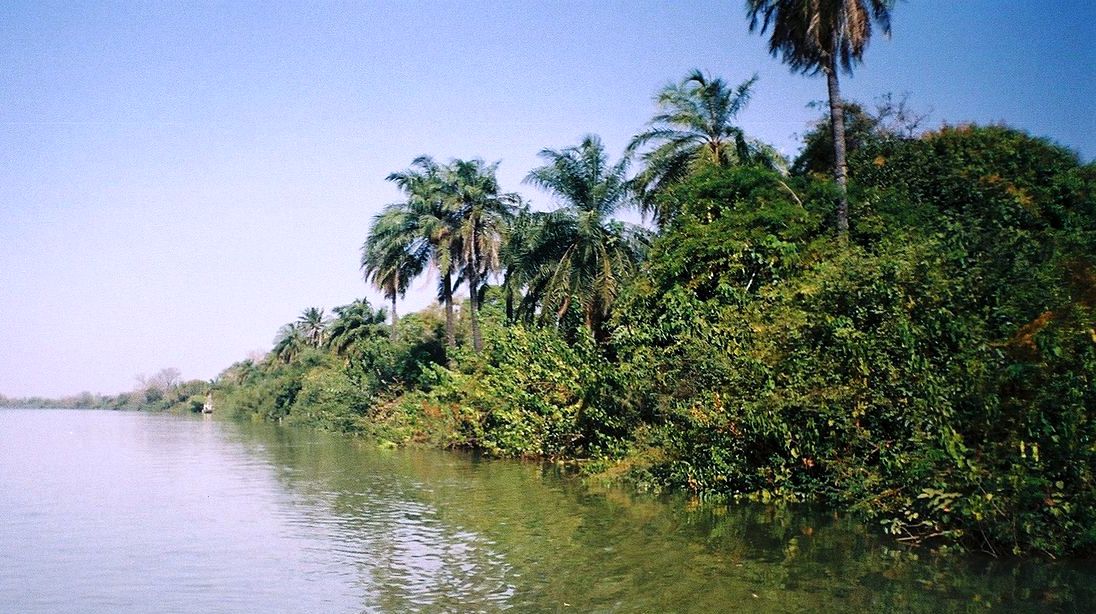
Gamibia was only established during colonisation. Adventurers, explorers and sailors from Europe scouted the fertile area around the Gamibia River. As the Europeans were only interested in the river and not the country, they only conquered the river banks. From their gunboats, they could defend the banks. This is how the country got its unusual form.
Landscapes
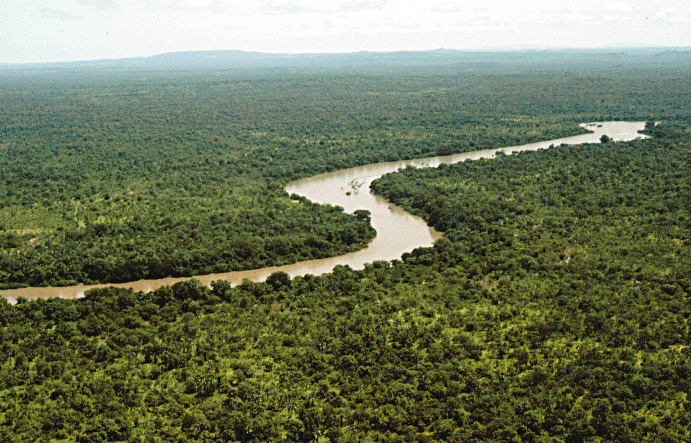 The red boundary line around the Gambia River shows how the country is almost entirely locked in by Senegal – only a short strip on the coast opens the door to the world. Gambia streteches like a snake from the Atlantic coast 500 km into the interior. Gallery forests grow along the banks of the river and run over into the savannah region. Huge baobab trees and kapok trees characterise the landscape.
The red boundary line around the Gambia River shows how the country is almost entirely locked in by Senegal – only a short strip on the coast opens the door to the world. Gambia streteches like a snake from the Atlantic coast 500 km into the interior. Gallery forests grow along the banks of the river and run over into the savannah region. Huge baobab trees and kapok trees characterise the landscape.
Banjul - the Capital of Gambia
 Banjul lies on the Atlantik. The small city, with its 31 000 inhabitants, is the capital city of Gambia. You can still see traces of the colonial past in the European-style buildings. The high minarets in the background show how the country is distinguished by Islam. The colourful markets, where farmers from the region sell their fruits and vegetables, are popular. Many craftsmen also sell their forged pans, pots and jewellery.
Banjul lies on the Atlantik. The small city, with its 31 000 inhabitants, is the capital city of Gambia. You can still see traces of the colonial past in the European-style buildings. The high minarets in the background show how the country is distinguished by Islam. The colourful markets, where farmers from the region sell their fruits and vegetables, are popular. Many craftsmen also sell their forged pans, pots and jewellery.
Peoples and Languages
The Mandinka people live in Gambia, as in the neighbouring country of Senegal. The Fula people, a pastoral tribe, and the Wolof, a farming tribe also live there. The official language is English, but the Gambians are polyglots, meaning that other than English, you can hear many different folk languages.
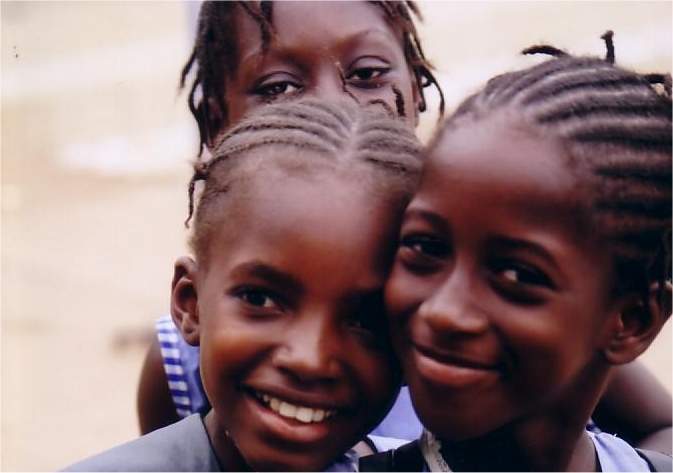
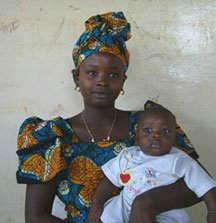
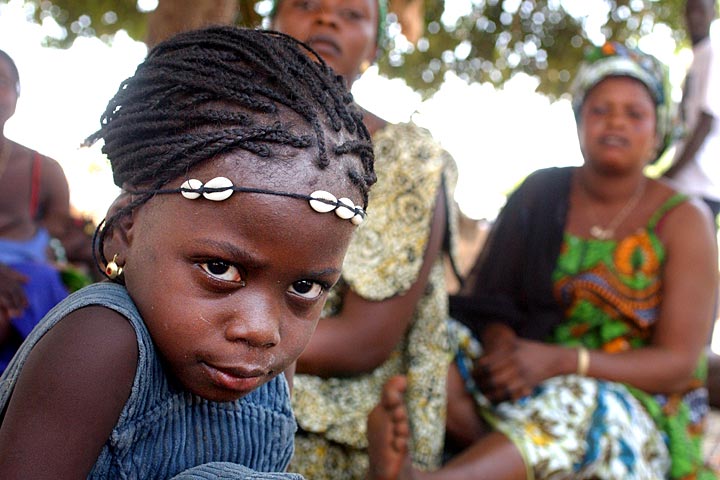
Almost all Gambians are Muslims, with a few Christians. Almost everyone also follows the natural religion of their ancestors. A peaceful coexistence exists between almost all of the religions. Gambia is a worldy country which demands respect for all cultures and traditions. In the villages, children live in large families, sometimes with 25 members or more. They live in round or square huts made of mudbrick, as tradition dictates. For the roof, they use reeds or straw. There is no electricity in most of the houses and also no running water. Fetching water from the water stations in the village is the duty of the children. Most girls have to look after their smaller siblings and help out in the household. Boys help supply the familiy income with their earnings from small jobs. The people in Gambia greet each other happily and elaborately – a greeting can last several minutes, as you have to ask after each family member, and inquire if everyone is healthy. Children refer to all adult women as 'mother' or 'aunt' and 'father' or 'uncle' to the men. It is considered disrespectful if you don't look at older people directly in the eyes when talking to them.
Schools and Education
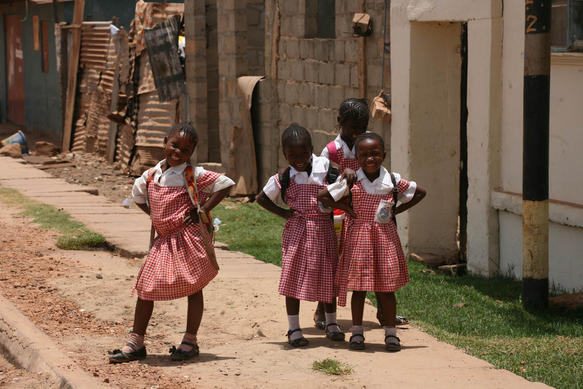 The Gambian girls are happy about two things: that school just finished and that they can attend school at all. In Gambia, not all children can attend school. School is only compulsory in Banjul and in the rest of the country there are school fees. These cost around 100-180 euros a year, which many parents can't afford. They are sad that their children cannot receive a basic western education. As a result of school fees, more than half of the people in Gambia can neither read nor write. As in almost all African countries, schools are modelled after the previous colonial powers. Gambia was once a British colony, which is why still today there is an English school system. There is a pre-school for children aged 4 to 7, and a primary school which they attend from the age of 7. Classes are often full, with 60 or 70 pupils per class. Due to having too few rooms, classes are often taught in shifts. Only a few parents can allow their children to have a tertiary education. Unfortunately, even with a university degree it is difficult to find a job as unemployment is very high in Gambia. However, their chances are still higher when they attended school.
The Gambian girls are happy about two things: that school just finished and that they can attend school at all. In Gambia, not all children can attend school. School is only compulsory in Banjul and in the rest of the country there are school fees. These cost around 100-180 euros a year, which many parents can't afford. They are sad that their children cannot receive a basic western education. As a result of school fees, more than half of the people in Gambia can neither read nor write. As in almost all African countries, schools are modelled after the previous colonial powers. Gambia was once a British colony, which is why still today there is an English school system. There is a pre-school for children aged 4 to 7, and a primary school which they attend from the age of 7. Classes are often full, with 60 or 70 pupils per class. Due to having too few rooms, classes are often taught in shifts. Only a few parents can allow their children to have a tertiary education. Unfortunately, even with a university degree it is difficult to find a job as unemployment is very high in Gambia. However, their chances are still higher when they attended school.
Games and Fun
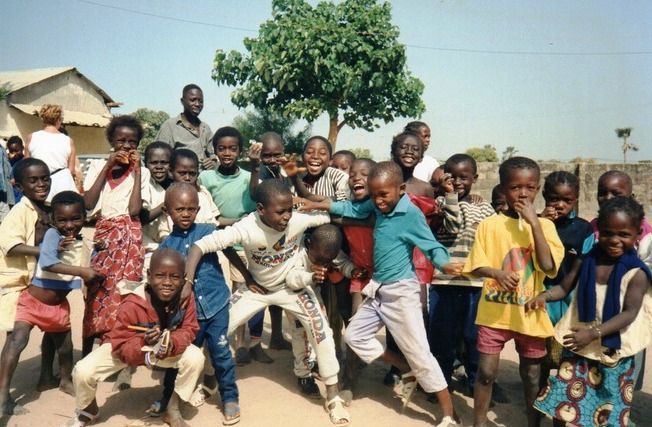 Due to lacking electricity, there are no televisions and so children in Gambia have to be creative. They make their own toys out of wire or empty plastic bottles. They make footballs out of plastic bags, straw and string, as football is their favourite sport. The older people enjoy traditional ring fighting. When the Tam Tams beat their drums, everyone comes together and cheers their team on. As in all communities in western Africa, music plays an important role. In earlier times, this served not only conversation, bu the transfer of knowledge. In Gambia in the 21st century, young people prefer listening to reggae music. Traditional food consists mainly of rice, fish and chicken. The favourite drink of the locals is palm wine.
Due to lacking electricity, there are no televisions and so children in Gambia have to be creative. They make their own toys out of wire or empty plastic bottles. They make footballs out of plastic bags, straw and string, as football is their favourite sport. The older people enjoy traditional ring fighting. When the Tam Tams beat their drums, everyone comes together and cheers their team on. As in all communities in western Africa, music plays an important role. In earlier times, this served not only conversation, bu the transfer of knowledge. In Gambia in the 21st century, young people prefer listening to reggae music. Traditional food consists mainly of rice, fish and chicken. The favourite drink of the locals is palm wine.
Economy and Natural Resources
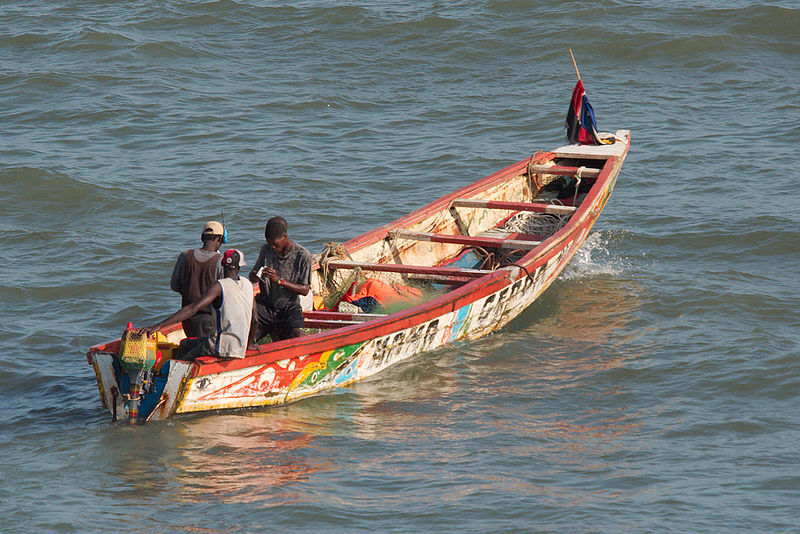 Most Gambians live off fishing or agriculture, but agriculture doesn't produce enough to feed everyone. This is why more and more Gambians look for a job in trade, tourism or administration, but only a few people manage to find an income here. Most adults are unemployed, and even the average income of the employed is very low. The average is around 17 euros per day, with which only one sack of rice, a little fish and sometimes meat can be bought. For things like clothes or school materials, the money often just isn't enough. As there is no health insurance, families can become poor through the illness of one family member. Even though Gambians aren't wealthy, their gardens are small paradises, in which a tropical sea of blossoms thrives. Many of the plants are widespread in all tropical regions on earth, for example the fire acacia, jacaranda trees, Hibiscus, oleander or Bougainvillea.
Most Gambians live off fishing or agriculture, but agriculture doesn't produce enough to feed everyone. This is why more and more Gambians look for a job in trade, tourism or administration, but only a few people manage to find an income here. Most adults are unemployed, and even the average income of the employed is very low. The average is around 17 euros per day, with which only one sack of rice, a little fish and sometimes meat can be bought. For things like clothes or school materials, the money often just isn't enough. As there is no health insurance, families can become poor through the illness of one family member. Even though Gambians aren't wealthy, their gardens are small paradises, in which a tropical sea of blossoms thrives. Many of the plants are widespread in all tropical regions on earth, for example the fire acacia, jacaranda trees, Hibiscus, oleander or Bougainvillea.
The Gambia River – an Animal Paradise
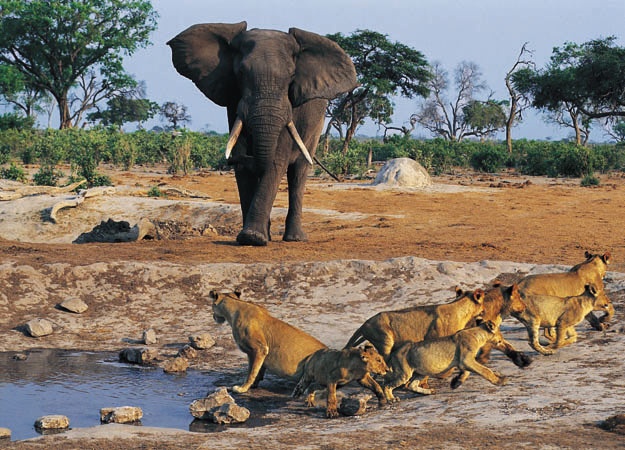 The big wild animals like the elephant in the picture on the left have become rare in Gambia. They have been hunted nearly into extinction by British colonial rulers and local poachers. But there are many wild pigs, antilopes, hyaenas and jackals. In the forests live meercats, hussar monkies or baboons. Many species of lizards, snakes and frogs are found on the banks of the Gambia River, which is also a bird paradise. 540 different bird species nest here. The Gambia River was once the river with the most crocodiles in Africa, but today only a few can be seen. This is very strange, as crocodiles have been considered holy animals since ancient times. The Gambians have come up with an idea to save their holy animals.
The big wild animals like the elephant in the picture on the left have become rare in Gambia. They have been hunted nearly into extinction by British colonial rulers and local poachers. But there are many wild pigs, antilopes, hyaenas and jackals. In the forests live meercats, hussar monkies or baboons. Many species of lizards, snakes and frogs are found on the banks of the Gambia River, which is also a bird paradise. 540 different bird species nest here. The Gambia River was once the river with the most crocodiles in Africa, but today only a few can be seen. This is very strange, as crocodiles have been considered holy animals since ancient times. The Gambians have come up with an idea to save their holy animals.
Stone Circles – a Landmark in Gambia
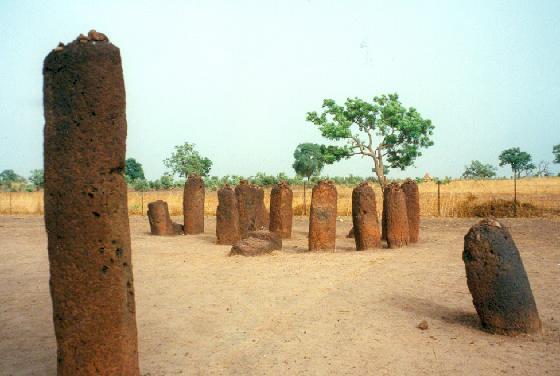 The stone circles of Wassu were raised in the 8th century on graves. They form the oldest megalithic construction in Africa. The stones weigh up to 10 tons each. They are between one and two and a half metres high and consist of laterite. Archaeologists today still don't know who built the stone circle or why. Weapons and arm jewellery found in the area helped form the theory that they are the graves of rulers. In a small museum in Wassu you can learn all about the stone circles. In accordance with tradition, visitors leave small stones on the stone blocks because they believe that it brings them luck.
The stone circles of Wassu were raised in the 8th century on graves. They form the oldest megalithic construction in Africa. The stones weigh up to 10 tons each. They are between one and two and a half metres high and consist of laterite. Archaeologists today still don't know who built the stone circle or why. Weapons and arm jewellery found in the area helped form the theory that they are the graves of rulers. In a small museum in Wassu you can learn all about the stone circles. In accordance with tradition, visitors leave small stones on the stone blocks because they believe that it brings them luck.
History of Gambia
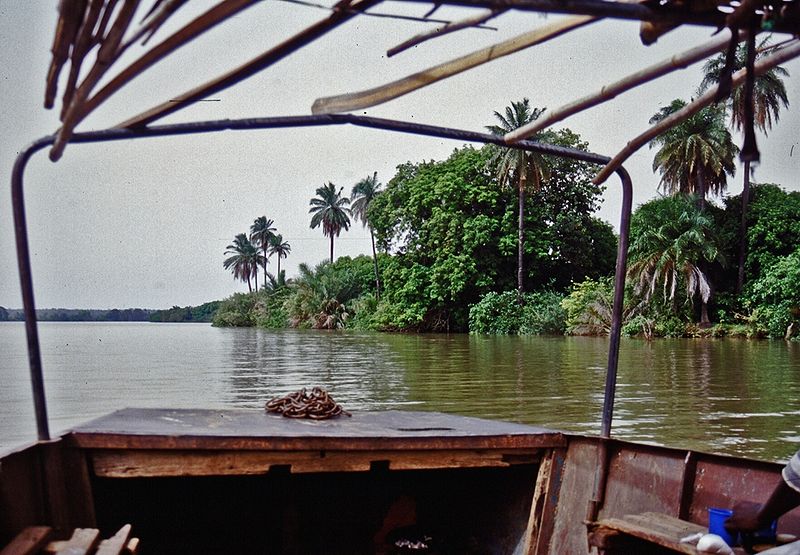 The fertile banks of the Gambia River have been populated for milleniums. The Carthaginian Hanno the Navigator, who travelled Africa around 470 BC, reported on the region around the Gambia River. When Islam spread through western Africa from the 8th century, the region around the Gambia River was also Islamised. After the Arabs, European sailors explored the west coast of Africa. When the Portuguese traders discovered the coast, Gambia was already an independent country. It belonged to the kingdom of Mali. Soon after, Englisch sailors and traders followed and the large Englisch trading companies begun to expand their trade to folk groups on the western coast of Africa. The region around the Gambia River was rich in resources and promised a large haul of precious wood and ivory, which is why a race for Gambia started between the French and the British. In the 19th century, the Gambia became a British Crown colony. On the 18th February 1965, Gambia gained its independence and a constitutional monarchy was formed. A few years later, it became an islamic republic. In 1981, a violent coup rattled the country.
The fertile banks of the Gambia River have been populated for milleniums. The Carthaginian Hanno the Navigator, who travelled Africa around 470 BC, reported on the region around the Gambia River. When Islam spread through western Africa from the 8th century, the region around the Gambia River was also Islamised. After the Arabs, European sailors explored the west coast of Africa. When the Portuguese traders discovered the coast, Gambia was already an independent country. It belonged to the kingdom of Mali. Soon after, Englisch sailors and traders followed and the large Englisch trading companies begun to expand their trade to folk groups on the western coast of Africa. The region around the Gambia River was rich in resources and promised a large haul of precious wood and ivory, which is why a race for Gambia started between the French and the British. In the 19th century, the Gambia became a British Crown colony. On the 18th February 1965, Gambia gained its independence and a constitutional monarchy was formed. A few years later, it became an islamic republic. In 1981, a violent coup rattled the country.
Gambia Today
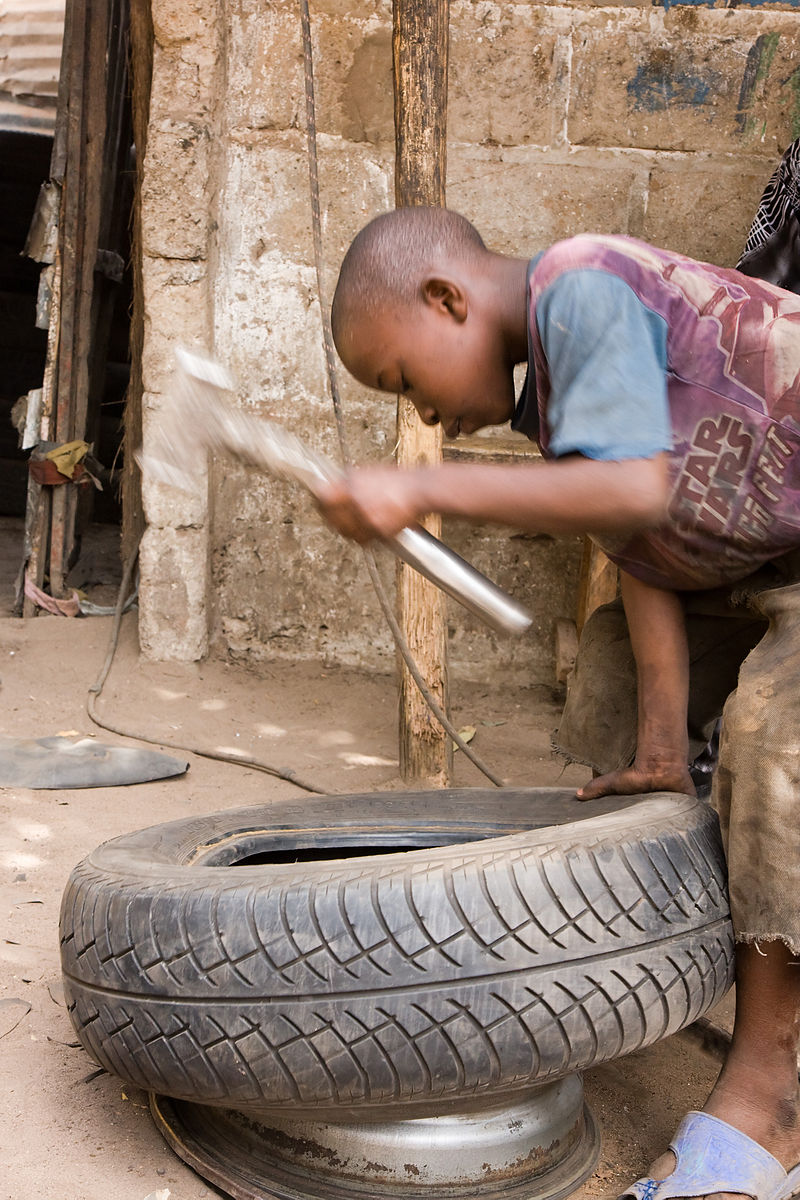 The inhabitants wish for reforms which will bring about more democracy. There is no freedom of the press. The Gambians also suffer from having no fair distribution of wealth. Many men have no jobs, that's why the women are contributing to the family income by farming and selling their products on the market. Children are starting to work at an early age like the boy on the right picture, wo is repairing wires. Many tourists who visit Gambia don't know much about the poverty in the country. But they bring money and their money creates more and more jobs.
The inhabitants wish for reforms which will bring about more democracy. There is no freedom of the press. The Gambians also suffer from having no fair distribution of wealth. Many men have no jobs, that's why the women are contributing to the family income by farming and selling their products on the market. Children are starting to work at an early age like the boy on the right picture, wo is repairing wires. Many tourists who visit Gambia don't know much about the poverty in the country. But they bring money and their money creates more and more jobs.


